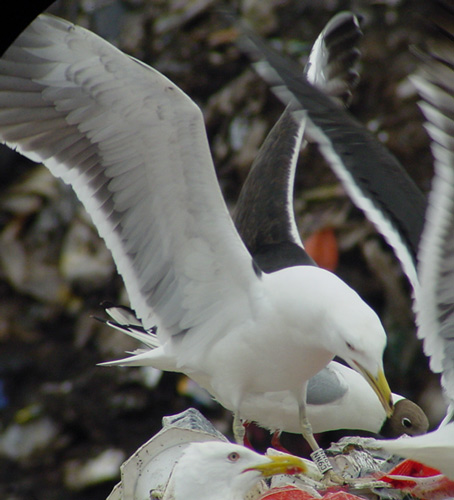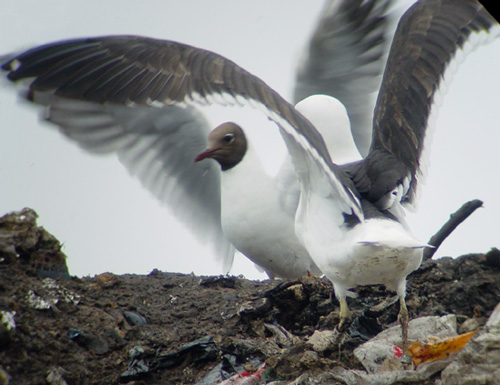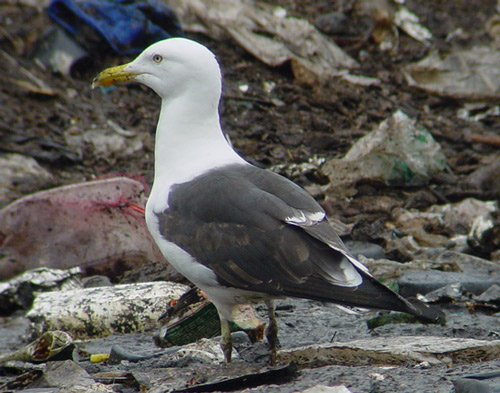
(4 images) Larus fuscus fuscus 3cy C9NN, July 09-12 2003, Tampere, Finland (61.33N 24.59E).
C9NN was ringed in Kanala, Finland; ringed as
pullus on June 25 2001.
Ring
records at Tampere landfill:
2003-05-20,
2003-05-21, 2003-05-24, 2003-05-25, 2003-05-28, 2003-05-29, 2003-05-30,
2003-05-31, 2003-06-03, 2003-06-07, 2003-06-14, 2003-06-15, 2003-06-16,
2003-06-17, 2003-06-18, 2003-06-22, 2003-07-02, 2003-07-09, 2003-07-10,
2003-07-12, 2003-07-20, 2003-07-23, 2003-07-24, 2003-07-26, 2003-08-02,
2003-08-03.
Larus fuscus fuscus in 2cy often returns
with completely replaced primaries and secondaries. In 3cy, fuscus more
often shows a clear division between fresh inner primaries and older outer
primaries, the inner primaries often showing neat white tips and the outer
primaries often second generation-like with rounded tips and paler bleached
brown. The arrested moult in the primaries is often reflected in the secondaries
and (to a less extend) in the tail-feathers as well. The older tail-feathers
(often R5 is older) still show a broad dark sub-terminal band.
3cy fuscus often have some black markings on the bill, which is otherwise
much adult-like, with a clear red gonydeal spot. The colour of the naked parts
are adult-like as well.
The scapulars in 3cy are often completely adult-like, lacking internal patterns;
plain blackish grey with a mahogany hue on the older feathers. Most wing-coverts
and tertials are adult-like blackish grey as well, but often 3cy birds show some
very bleached pale brown wing-coverts, normally in the greater covert bar and in
the upper rows of the lesser coverts. These bleached wing-coverts accentuate the
jumpy sequence in the last wing-covert moult cycles, as there is often no clear
pattern in location of these bleached feathers. Head and body feathers normally
are snow-white by July.
C9NN was ringed as pullus at Kanala,
Finland on June 24 2001, now in 3cy. Secondaries and rectrices most 3rd generation,
with one inner secondary in the right arm (approx. S17) of an older generation, as it appears bleached pale brown. Normally,
S17-S18 are the last moulted secondaries in the arm, where the two moult waves
meet, from the outer-arm (starting at S1 at the division between primaries and
secondaries) and inner-arm (starting much later, moulting from the body
outwards). Note the black markings on the outer tail-feather, visible in the 4th
image, suggesting that not all tail-feathers were included in the pre-breeding
moult last winter.
Primary moult arrested at P1, at least in the left wing (right wing not seen
well enough). P2-P10 seem to be all of the same generation, judged by the tips,
probably second generation.



